PSYCHODIDAE NOTES
This journal entry is somewhat of an experiment to see what HTML I can use here. There's a bit of a clash with the site's CSS, so it doesn't look quite right. I also note I don't seem to be able to use HTML in the title, and nested table tags don't work. That said, I think the information here is useful enough to post. My main work file will be kept locally. I may update this entry from time to time as I get new information.
The way the table, below, is organized, the family is divide by subfamily, then tribe, then genus and species. Photos are from iNat and Bugguide for the most part. Click an image to get to the observation. Click the name to the left to get to the info page on that species. Additional notes are added in text, some with hyperlinks. By all means, post a comment if you notice information that is wrong. Additionally, if you have information not included here, please post that as well.
Important note: I am not an expert on Psychodidae. This document serves as a central place for me to gather notes from reading I have done on the family. Feel free to use it as a resource if you like, but it should be considered a secondary or tertiary resource.
Bruchomyiinae |
||
| Nemopalpus nearcticus |  |
|
| Notofairchildia zelandiae |  |
Endemic to New Zealand |
Psychodinae |
||
Maruinini |
||
| Maruina lanceolata |
 
|
|
| Maruina |  |
|
| Maruina |  |
|
| Paratelmatoscopus variegatus |  |
|
| Paratelmatoscopus |  |
|
Mormiini |
||
| Brunettia alternata |  |
|
| Brunettia ishiharai |  |
|
| Brunettia | Subgenus Atrichobrunettia

|
|
Paramormiini |
||
| Clogmia albipunctata |  |
Probably the most common species in the family, found all over the world. |
| Clogmia latipennis |  |
Has black down the center and back of head, unlike Clogmia rothschildi Similar to Lepiseodina conspicua |
| Clogmia rothschildi |  |
Similar to Clogmia latipennis but hairs on head are all blond. |
| Eurygarka |  |
|
| Feuerborniella obscura |  |
|
| Lepiseodina | Found in America | |
| Lepiseodina conspicua |  |
Clogmia latipennis looks similar but is found in Italy. |
| Lepiseodina superba |  |
|
| Paramormia furcata |  |
Apparently, easily recognized by the distinct pattern of spots on the wings and pattern of light and dark segments on the antennae. |
| Paramormia ustulata |  |
Apparently, easily recognized by the distinct pattern of spots on the wings and pattern of light and dark segments on the antennae. |
| Peripsychoda fusca |  |
|
| Philosepedon |
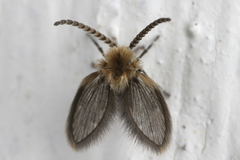 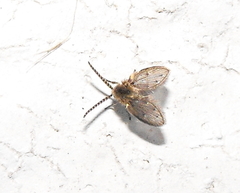
|
|
Pericomini |
||
| Clytocerus | Adult males and females of Clytocerus are among the most easily recognized species of Psychodinae due to the extremely elongate scape and the distinct frontal setae alveoli arranged in two subcircular groups. | |
| Clytocerus americana = americanus |  |
Clytocerus (B.) americanus is common throughout the eastern United States, from western Kentucky to eastern Maryland, and from Maine to southern Alabama. It has also been collected in Illinois, Wisconsin, Minnesota, California, Washington, and Ontario (Quate 1955). A lack of records from the southwestern United States could be due to fewer collections, but probably indicates a lack of suitable habitat. CurlerMoulton2012Clytocerus.pdf describes a similar, smaller species, C. microlimnetes known from Tennessee, Alabama, North Carolina, and Kentucky. |
| Clytocerus splendidus |  |
Europe |
| Clytocerus ocellaris |  |
Europe |
| Clytocerus unidentified |


|
|
| Pericoma fuliginosa |  |
|
| Pericoma illustrata |  |
|
| Pericoma signata |  |
|
| Pericoma sp. | 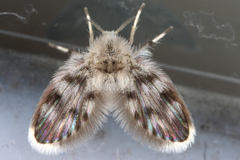 |
|
| Pneumia trivialis |  |
|
| Pneumia |  |
|
| Satchelliella compta |  |
|
| Satchelliella mutua |  |
|
| Stupkaiella |
 
|
|
| Logima | I will consider these as Psychoda for now. https://www.aemnp.eu/data/article-1041/1022-41_0_213.pdf Differential diagnosis: Genera Logima Eaton, 1904, Tinearia Schellenberg, 1803, Ypsydocha Ježek, 1983a, Psychoda Latreille, 1796 and Copropsychoda Vaillant, 1971 have antennae with 15 or 14 segments and there are mostly huge differences in their size of the last three antennal segments. On the other hand genera Psychodula Jažek, 1983a, Chodopsycha Ježek, 1983a, Psychomora Ježek, 1983a and Psychodocha Ježek, 1983a antennae are 16 segmented and there are mostly small differences in the size of the last three reduced antennal segments, however a swelling setae is not considered as a segment. Antennae both of genus Logima Eaton, 1904 and Copropsychoda Vaillant, 1971 14 segmented, remainders of one or more spines penultimate pseudoantennal segment. On the other hand genera Ypsychdocha Ježek, 1983a, Psychoda Latreille, 1796 and Tinearia Schellenberg, 1803 with 15 segmented antennae and spines or their remainders on penultimate antennal segment mostly missing. Antennal segment 12 with a narrowed part in genus Logima Eaton, 1904, more or less swollen part between fused segments 13 and 14 developed, both radial and medial forks of the wing veins uninterrupted. In genus Copropsychoda Vaillant, 1971 antennal segment 12 without a neck part, more or less swollen part between fused segments 13 and 14 missing, both radial and medial forks of the wing veins interrupted. Distribution: 21 species in the world - Australian area (5), New Zealand area (1), Polynesian area (2), Indo-malayan area (7), Holarctic area (6). |
|
| Logima sigma | See Psychoda sigma | |
| Logima surcoufi | See of Psychoda sigma | |
Psychodini |
||
| Psychoda acutipennis | 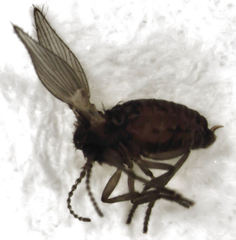 |
|
| Psychoda alternata |  |
Worldwide, originating in North America |
| Psychoda cinerea | 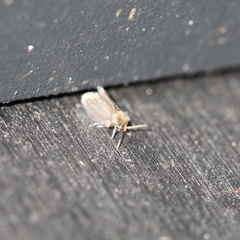 |
|
| Psychoda griscescens | Image | |
| Psychoda sigma |  |
For now I consider P. sigma, P. surcoufi, Logima sigma, and L. surcoufi to all refer to Psychoda sigma. |
| Psychoda |  |
|
| Quatiella |
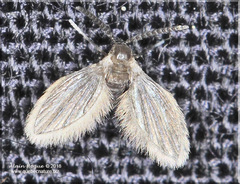   
|
|
Setomimini |
||
| Setomima nitida |
 
|
|
| Tinearia | Browse | |
| Threticus bicolor |  |
|
| Tonnoiriella pulchra |  |
|
Unidentified |
||
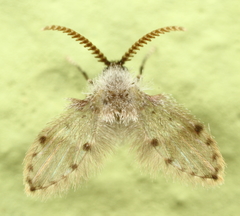 |
||
 |
||
 |
||
 |
||
 |
||
Phlebotominae |
||
| Lutzomyia cayennensis |  |
|
| Micropygomyia vexator |  |
Click picture to see larger version. Flies are infesting snake habitat. |
| Lutzomyia sp. |  |
|
| Phlebotomus papatasi |  |
|
| Phlebotomus |  |
|
Trichomyiinae |
||
| Trichomyia urbica |  |
|
| Trichomyia |  |
|
| Trichomyia |  |



